

Peterson 34
This fast, tough racer-cruiser is well suited for offshore racing.
American yacht designer Doug Peterson gained the attention of the world’s most competitive sailors when he unveiled the one tonner Ganbare in 1973. The 35-foot sloop was innovative below the waterline, and it was praised for its looks and sailing capability. It went on to win the SORC. By 1976, Peterson had designed the Peterson 34, an offshore racer-cruiser.
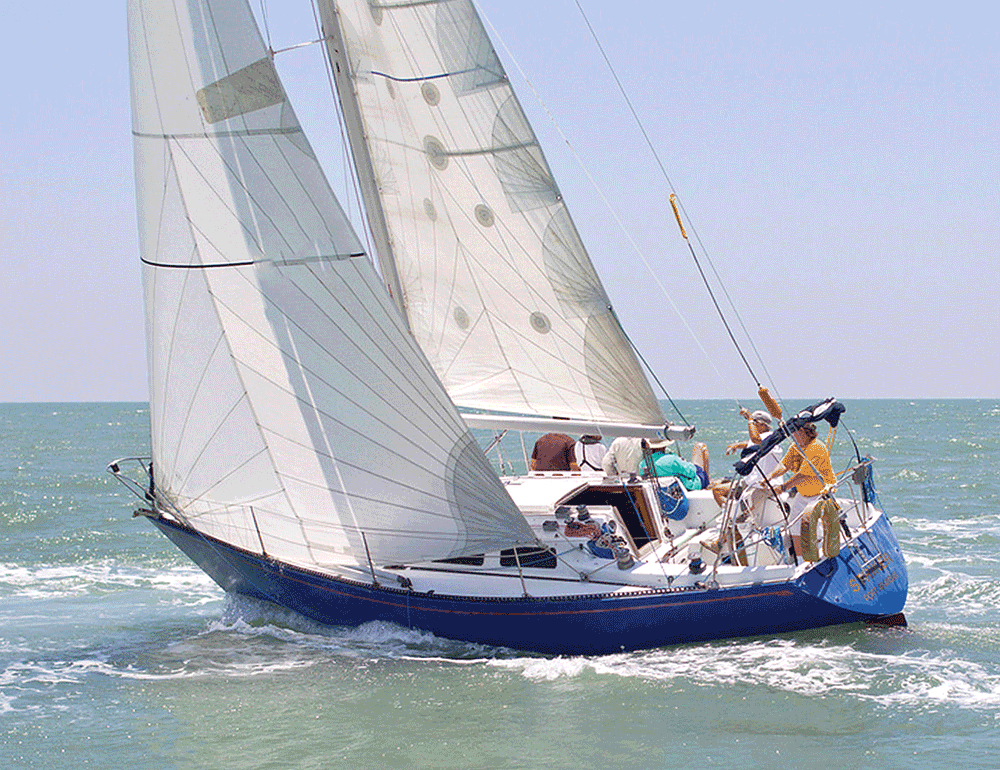
The Peterson 34 went into production at Texas-based Island Yachts/Composite Technologies, and 92 were built until production ceased in 1981. Composite Technologies, established by boatbuilder Andy Green in Corpus Christi, Texas, was acquired sometime around 1976 by boatbuilder and rigger Marion Hayes. Hayes renamed the company Island Yacht Corp. and relocated production to League City, Texas.
It was during this era that Peterson’s designs dominated offshore racing, with winning IOR boats Gumboots , Eclipse , and Ragamuffin . He also designed several stock racers such as the Contessa 35 and the New York 40.
The majority of Peterson’s performance cruisers were considered rugged enough for ocean racing. Peterson once said the 34 “was built to deliver about eight people quickly and safely from point A to point B.”
First impressions
The Peterson 34 is as fast as it looks, and this quality solidified Peterson’s reputation as a designer. The sloop’s profile from abeam is sleek, the sharp cut bow and reverse transom give the boat a sense of forward motion.
The dimensions are well proportioned—the 11-foot 2-inch beam is just about one-third of the boat’s 33-foot 11-inch overall length. The smooth, rounded deck contour is clearly designed to shed seawater. The compact cockpit, with its oceangoing bridgedeck, allows room for a tiller but little else. The traveler is mounted across the bridgedeck. Trimmers can easily reach the primary and secondary winches, none of which were originally self-tailing.
Also in Used Boat Notebook
- Hunter Passage 42
- Pearson Rhodes 41
- Santa Cruz 52
- Allied Princess 36
- Kelly-Peterson 46
Also from David Liscio
- Chasing a dream
- The wide, wide world of multihulls
- Flares are expired. Now what?
- Saved from the scrap heap
- Pedal to the Medal
Great choice! Your favorites are temporarily saved for this session. Sign in to save them permanently, access them on any device, and receive relevant alerts.
- Sailboat Guide
Doug Peterson
Douglas Blair Peterson (July 25, 1945 – June 26, 2017) was an American yacht designer. Beginning with the One Tonner Ganbare in 1973, Peterson’s designs have pioneered many innovations in racing and cruising yachts After nearly winning the 1973 International One Ton Cup, Doug Peterson stated in an interview: “I started putting boats down on paper when I was 10, and have never wanted to do anything else.” This was GANBARE, clearly the fastest boat in the series (though, due to some tactical errors, she didn’t actually win). Built on a shoe string budget, and a huge gamble financially for him personally, GANBARE was the boat that clearly established his reputation. Another Peterson design, ‘Gumboots’, easily won the following year, proving that no other designer had ‘caught up’. Almost immediately, Doug Peterson became the designer in demand for IOR racing sailboats, around the world, for more than a decade. His firm employed many who went on to establish their own reputations as designers of racing sailboats. Later he became involved in several Americas Cup campaigns. A tribute page to this legendary designer has been set up on Facebook. Please click on the link above to contribute content.
66 Sailboats designed by Doug Peterson

Jeanneau Sun Legende 41

Peterson 44 Cutter

Kelly-Peterson 44

Peterson 34

Ood 34 (Contessa)

Contessa 35

Baltic 38 DP

Baltic 42 DP

Contention 30 (Peterson)
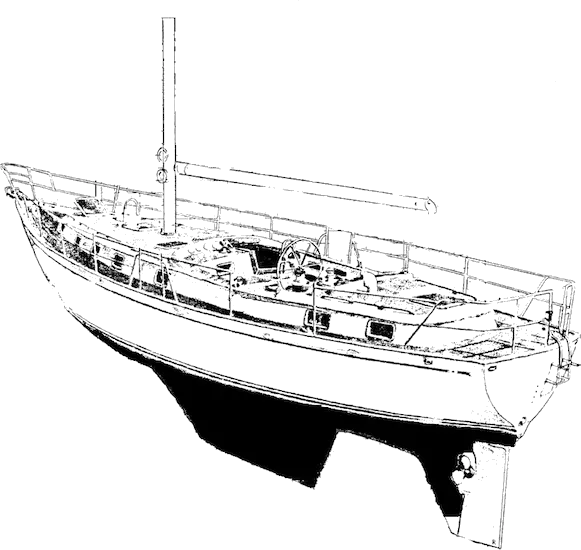
Kelly-Peterson 46
Grand soleil 50 (1992).

Serendipity 43

New York 40 (Peterson)
Ny 40 (peterson), peterson 36.

Baltic 48 DP

Cavalier 36

Passport 45 (Hoyt)

Contessa 39
Contessa 25 (peterson).

Baltic 55 DP

Peterson 38
Pinnacle 29.

Peterson 25 1/4 Ton

Bavaria Match 42

MG 26 (Peterson)
Jeanneau legende 1 ton.

Jeanneau Sun Fast 41

Bavaria Match 38
Peterson 30 1/2 ton.

Bavaria Match 35

Peterson 33 Chita
Hans christian christina 48.

Hans Christian Christina 52

Islander 40
Jongert 21s, cavalier 26.

Contention 33 (Peterson)

Impala 36 (Peterson)
Olympic sea 42.

Serendipity 43 R/C

Blazer 23 (Peterson)

8M One Design
Wiggers 37 (peterson).

Peterson 37

Contessa 43

Contessa 28

Pinnacle 30
Chita peterson 30.

Tartan Tangent One

- About Sailboat Guide
©2024 Sea Time Tech, LLC
This site is protected by reCAPTCHA and the Google Privacy Policy and Terms of Service apply.
Sailing Whimsy
Adventures on a classic Pearson 35 sailboat
Saturday, March 4, 2017
Restoring a classic pearson 35 sailboat.

7 comments:
I purchased a Pearson 35 last summer. She needs work. I'm interested in following your work.
We purchased a 1976 Pearson 35 last year. She's in very good condition and surveyed so. We did change the pendant cable last year before we splashed her in. We're did repower this year. However most other work is cosmetic and personalization. Good luck with the project
SV Whimsy, fantastic that you are sharing this info! I just bought a '71 Pearson 35. My biggest concerns right now are repairing the mast support - which I see you have had to do too - and removing/refabbing the forward/bow water tank so i can repair a hole in my starboard bow! I have been trying to remove the tank by cutting around the edges of the "well" with a multi-tool. i've cut through two layers of fiberglass that seemed to attach the top perimeter to the hull and vberth frame, and the two wood/fg tabs on the aft end. but it still doesn't budge. have you gotten to that project yet? or know more about how that tank is secured and how to remove it without just carving it up?
We just purchased a 1970 Pearson 35 in Febuary and are so excited to begin restoring her! So happy you have shared your journey with the rest of us, so we can learn and get an idea of what we are getting into with each new project
I was recently given a 1979 Pearson 35. It seems to be in good condition except for needing a lot of cleaning. One question, does it have a holding tank?
I my hull number 104, the holding tank is the port side tank. It used to be one of the three water tanks. With the new regulations mandating a holding tank we utilized the port water tank. I recommend installing an electronic gauge to provide a means of knowing when the tank is filling up. Don't want any surprises during a long sail. https://www.internationalmarineservice.com/Albin-Pump-Marine-Tank-Level-Indicator-Kit-12-24-p/alb-03-66-012.htm
Was wanting to know if you replaced any of the cabin sole? I have hull 36. It looks like to me that the whole sole structure was built outside of the hull and then dropped In and glassed in around the edges only, I was wanting to know if I can tab in and glass the new sole supports to the hull and then lay new flooring and glass it back to the edges Thanks in advance Ed Zurcher

- Forums New posts Unanswered threads Register Top Posts Email
- What's new New posts New Posts (legacy) Latest activity New media
- Media New media New comments
- Boat Info Downloads Weekly Quiz Topic FAQ 10000boatnames.com
- Classifieds Sell Your Boat Used Gear for Sale
- Parts General Marine Parts Hunter Beneteau Catalina MacGregor Oday
- Help Terms of Use Monday Mail Subscribe Monday Mail Unsubscribe
Is a P35 1969 a good buy?
- Thread starter SammyDPR
- Start date Oct 27, 2011
- Brand-Specific Forums
Hi everyone! We are a couple getting into sailing, and looking in the local market, there is a P35 '69 that is for sale, they say in the add that it has not been used for a couple of months. Very motivated to sell. While doing research in the boat i saw that it has a retractable daggerboard that extends the keel to over 7' feet. That retractable daggerboard must use some kind of system that i don't even have a clue how that could work. Especially in salt water. That has really got me hesitating a lot. Anyone have a p35, especially from the same year that can share your thoughts on how your experience with the boat has been? What things to look out for? With the little research I have done I have noticed that the best hulls made in the p35 were from the 1st couple of years. The P35 started production in 1968 which puts this boat right in the "best quality" hulls from that model. Some have been found without any blisters. Just read it in a web site don't quote me on it, ok, lol. Or maybe I should run to the Pearson 323 1980 that is also on sale in the local market. With its more expensive price tag. Any help, input, advice that could help us in making the best decision with all the information we can gather. It will be greatly appreciated! Best Regards, Sammy
Wanderer138
There is an excellent review of the Pearson 35 in Gregg Nestor's "Twenty Affordable Sailboats to Take You Anywhere". If you're in the market for an affordable mid-size cruiser I highly recommend that book. My 1969 Pearson Wanderer is similar to the P35 but smaller. She is sturdily built, has a nice motion under way and is surprisingly fast. The keel is nearly full with internal lead ballast and a pivoting fiberglass centerboard for added area when sailing close-winded. I rarely use the board. Its lifting mechanism is a hand line wound on a drum on the same axle as a second, smaller drum with stainless wire rope that lifts the keel. Even before you hire a marine surveyor, I'd suggest you visit the boat on a rainy day to see what it's like being closed in belowdecks. The surveyor will find problems; all boats have them. The trick is to avoid a boat with the kinds of problems that will prevent you from sailing her while you fix them. Good luck. Peter
Thank you! Wanderer138 for taking some time to share your experience with your pearson with daggerboard. The owner said that is a very dry boat. I will be checking it this weekend.
Here are pictures of the Wanderer centerboard and lifting mechanism. The stainless wire rope attaches to the back of the board near the top. It goes up into a metal tube inside the hull that runs under the cabin floor and turns up at the front of the engine bay to a small drum (the one on the left) just under the companionway. You can see the tube and the drums in the last picture. The white line on the large drum goes through a hole to a cam cleat in the front of the cockpit. It is a very simple system but the wire rope should be checked, greased liberally (and possibly replaced) every time the boat is hauled for bottom paint. What you don't see in the pictures is how much trouble I had replacing that wire rope when it broke inside the tube as I was lifting the board back into place after cleaning and painting it. You can also try yachtworld.com and use the advanced search to find other Pearson 35's for sale. I found 17 of them. Click on each boat, then click either the Photo Gallery or Full Specs button to see more pictures. Here is a link to one P35 that was out of the water so you can see the partially lowered centerboard: http://www.yachtworld.com/boats/1969/Pearson-35-2347766/Deltaville/VA/United-States Good luck in your search
Attachments

Depnds I sailed on a friends P35 for many years They are good solidly built boats what you call a dagger board is actually a centerboard that retracts into the keel. These boats were built with shallow water in mind. Keel centerboard need maintenece that full keels dont. The 323 is a full keel a bit smaller but somewhat stiffer. The choice is yours In either case get a good survey on either boat
- This site uses cookies to help personalise content, tailor your experience and to keep you logged in if you register. By continuing to use this site, you are consenting to our use of cookies. Accept Learn more…
- 0 Shopping Cart £ 0.00 -->
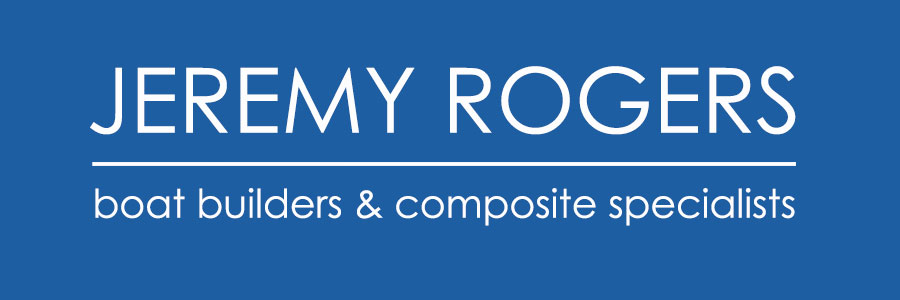
All about Contessa
Contessa is a brand associated with seaworthiness and adventure, beauty and integrity.
There were around 350 CO26s built in Lymington and a further 400 or so under licence in Canada. The Contessa 26 has a loyal following all around the world. Often chosen as a world girdling expedition boat , the Contessa 26 also races at the highest level – winning the coveted Round the Island Gold Roman Bowl a total of five times with Jeremy Rogers’ own CO26 ‘Rosina’ responsible for three wins . The Contessa 26 enjoys the benefit of an active and friendly Class Association .
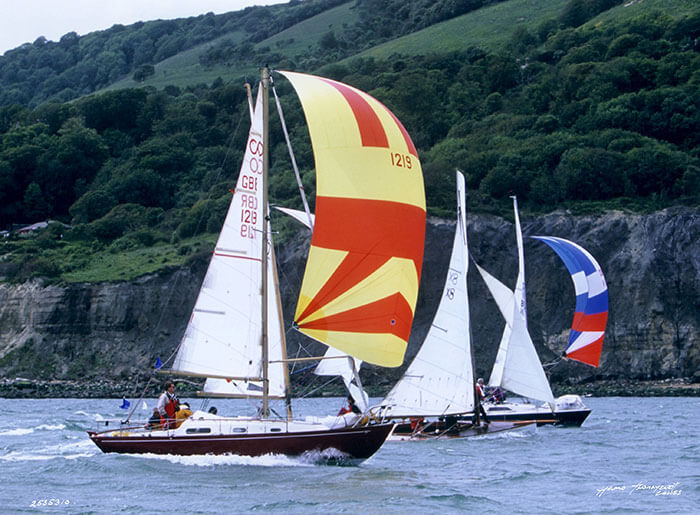
Image: Contessa 26 ‘Rosina’
Production of Contessas exploded during the 1970s with the incredibly popular CONTESSA 32 designed in collaboration with David Sadler.
The Contessa 32 also enjoys an active and friendly Class Association with a full racing programme .
1973 saw the launch of the first SPARKMAN & STEPHENS CONTESSA 38 taking part in the One Ton Cup in Sardinia. Production of the S&S 38 was limited to just 6 boats.
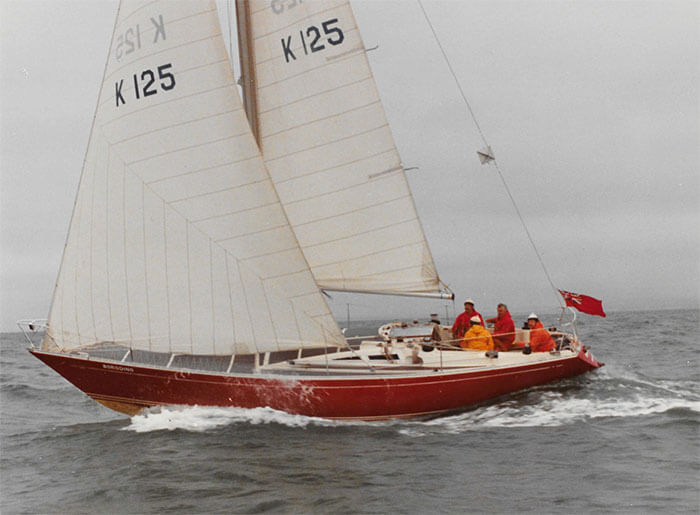
Image: Sparkman & Stephens Contessa 38
In 1975 the quarter tonner ‘Hobnail’ was launched and a further 22 of these CONTESSA 25 hulls were built.
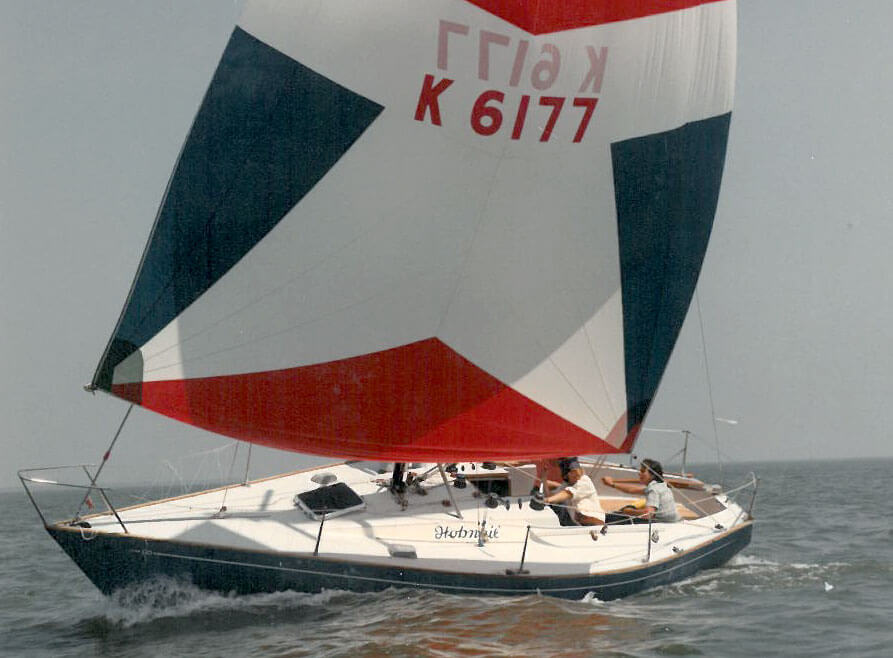
Image: Contessa 25 ‘ Hobnail’
In 1979 David Allan Williams designed the CONTESSA 38 as a larger alternative to the CO32. Seven of these are still part of the Royal Navy’s fleet used for adventurous training.
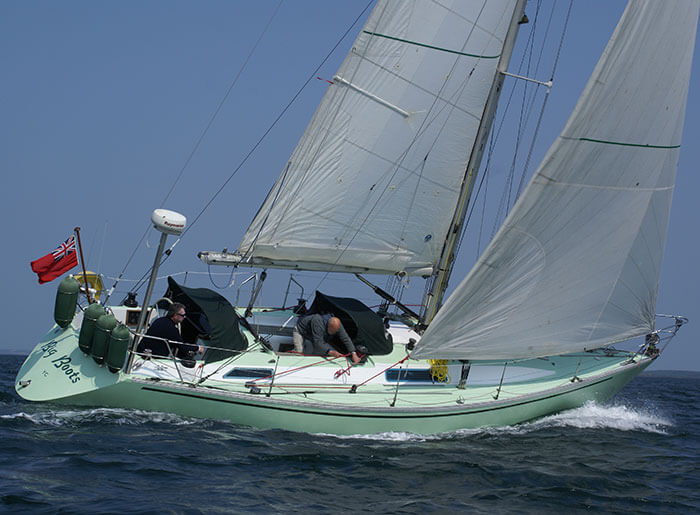
Image: Contessa 39
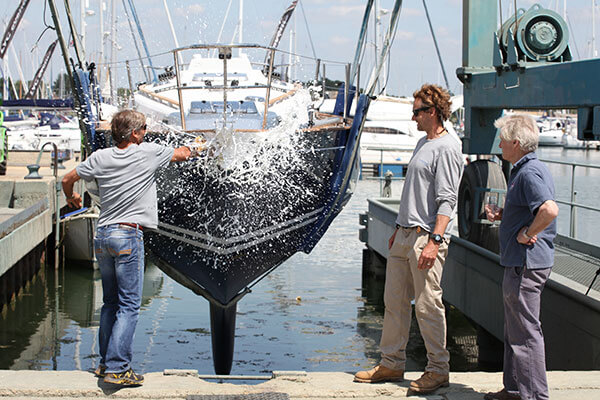
Contessa 32 New Builds
When you commission a new Contessa 32 you are embarking on an exciting journey, one that may have started in your imagination a very long time ago. Although all Contessa 32s are built using the same hull and deck mould, each boat is built in close consultation with the owner and has a unique character.
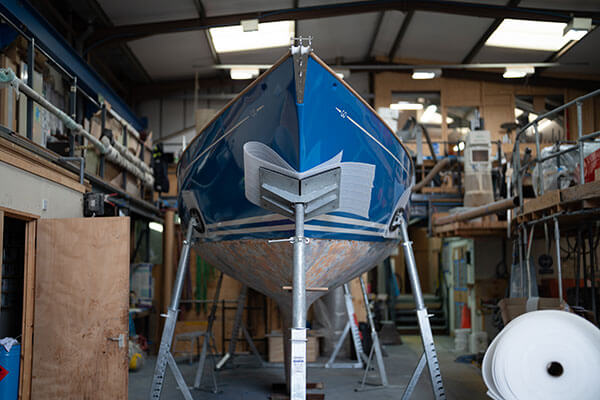
Contessa Refurbishment
Being the original builder of the Contessa we are the obvious place to bring your boat for a refurbishment. We have an unrivalled skill and knowledge set and understand what it takes to restore your boat sympathetically and beautifully.
Contessa Video
Enjoy our short promotional video of the Contessa 32 – a whistlestop tour of the many adventures to be had on this truly exceptional boat. Racing, cruising, dreaming. Go with the wind – Anywhere!
Environment & Compliance
Privacy policy
General Enquiries Tel: +44 (0)1590 646780 Email: [email protected]
Atlas Davit Enquiries Tel: +44 (0)1590 646780 Email: [email protected]
Jeremy Rogers Limited Lymington Yacht Haven Kings Saltern Road Lymington Hampshire SO41 3QD
- BOAT OF THE YEAR
- Newsletters
- Sailboat Reviews
- Boating Safety
- Sailing Totem
- Charter Resources
- Destinations
- Galley Recipes
- Living Aboard
- Sails and Rigging
- Maintenance
- Best Marine Electronics & Technology

Peterson 44
- By Joe Minick
- Updated: August 5, 2002
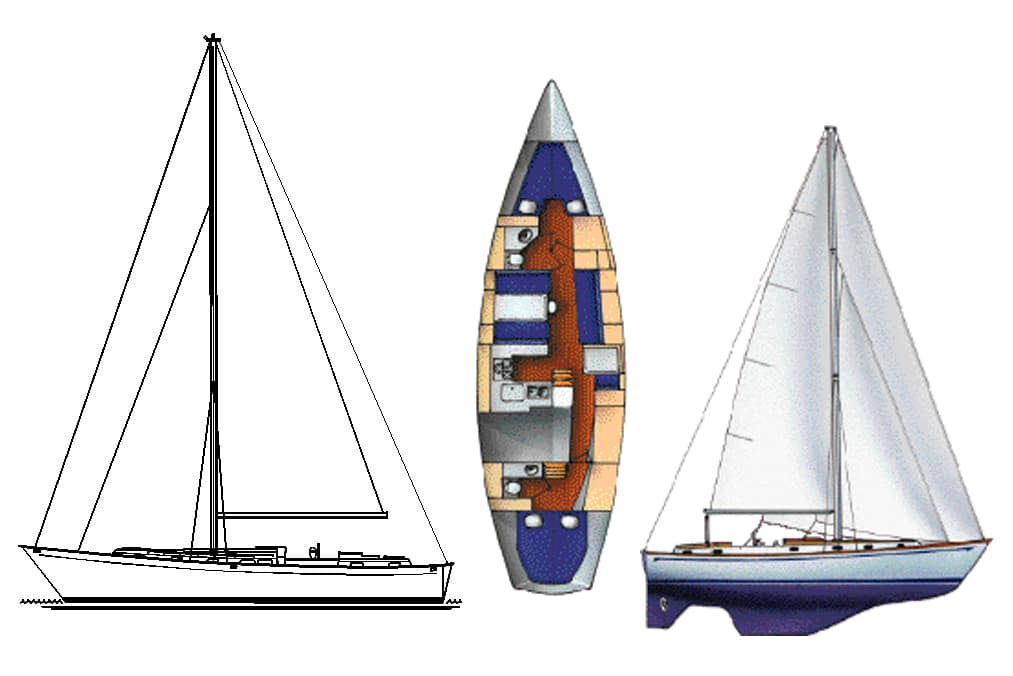
This boat was a pioneer in performance cruising design. Drawn for Jack Kelly Yachts by Doug Peterson, the 44 debuted in 1976 as a dedicated cruiser that could sail well in any wind. Today, in many major cruising ports you can find one of the over 200 44s originally built. Owners have nothing but praise for the performance achieved by this moderate-displacement bluewater design; 180-mile days are not uncommon.
The Peterson 44 features a low-profile center cockpit that remains pleasing to the eye and keeps weight low physically as well as visually. The long-fin keel with cutaway forefoot and afterbody reduces wetted surface for good light-air performance and provides a shorter turning radius. A full-size molded-in skeg supports the rudder and provides good protection during the occasional grounding. Protected also is the prop, mounted in an aperture between the skeg and the rudder. Displacement of 30,000 pounds (10,000 of this is buried in encapsulated lead ballast) gives the Peterson 44 an easy motion at sea.
On deck, a double-spreader cutter rig supports 1,011 square feet of working sail. The center cockpit is intelligently laid out and accommodates a full-size dodger and Bimini. From the cockpit, two companionways, both protected by bridge decks, provide outside access to the fore and aft cabins. Each Peterson 44 was delivered with factory-installed bow rollers and a manual windlass. Most boats’ windlasses have been replaced with electric versions, but the bow rollers and chain lockers are still adequate, although some owners have beefed up their rollers to handle side loads better. The deck and coachroof are cored with plywood and generally have stood up well.
Entering the main cabin through the forward companionway reveals one of the better belowdeck layouts you’ll find in a center-cockpit cruiser. A full-size U-shaped galley is located to port near amidships. It easily accommodates a good-size freezer and refrigerator without compromising storage or counter space, and with room for a sizeable double sink.
To starboard is a large, first-class nav station, close enough to the cockpit for easy communication. To starboard and back through the passageway is the aft cabin, with a double berth and separate head with shower. Forward is a traditional main cabin layout with dinette to port and settee to starboard, a second head with shower and a reasonably large V-berth. The tri-cabin accommodates seven. Three hatches and six opening ports ventilate the main cabin; four ports and two hatches ventilate the aft cabin.
Under the cockpit and accessible from the passageway is the engine and equipment space, which contained originally a 62-hp Perkins 4-152 diesel though some boats were delivered with Ford Lehman 80-hp diesels. The larger engine is a good match for a boat of this displacement. A nine-foot prop shaft incorporates two cutless bearings, one at each end of the long stern tube, to provide extra support. The forward cutless is hidden behind the shaft log and may escape periodic inspection.
Storage is excellent, with abundant locker space for the long-haul voyager. Four separate stainless steel tanks carry 132 gallons of water, and fuel capacity is 117 gallons in two painted steel tanks. The tanks have been a minor source of difficulty: Over the years, they have developed cracks and leaks that could only be stopped by tank replacement. Problems with fuel tanks are less common.
Underway, the Peterson is easy on the helm. A servo-pendulum windvane will handle steering chores even with the long run of control lines to the center-cockpit-mounted wheel; most autopilots will steer happily as well. Owners report that heaving to with a reefed main and staysail set is the preferred heavy weather strategy.
Most owners will tell you it is the boat’s sailing performance that impresses them most. With ready-to-go, well-equipped versions of this boat selling for $110,000 to $125,000, brokers often have waiting lists.
Peterson 44 Specifications
- LOA: 43’10” (13,36 m.)
- LWL: LWL 38’8″ (11.78 m.)
- Beam: 12’11” (3.93 m.)
- Draft 6’4″ (1.98 m.)
- Ballast: 10,000 lbs. (4,536 kgs.)
- Disp: 30,000 lbs. (13,607 kgs.)
- Sail area: (100%) 1,011 sq.ft. (93.92 sq.m.)
- Ballast/Disp: .33
- Disp/Length: 232
- SA/Disp: 16.7
- Fuel: 117 gal. (443 ltr.)
- Water: 132 gal. (500 ltr.)
- Auxiliary: 62-hp Perkins 4-152 diesel
- Designer: Doug Peterson
- More: 41 - 50 ft , before 2000 , Bluewater Cruising , keelboat , monohull , peterson , Sailboat Reviews , Sailboats
- More Sailboats

Meet the Bali 5.8


Celebrating a Classic

New to the Fleet: Italia Yachts 12.98
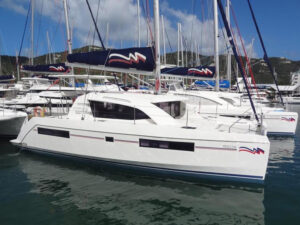
Leopard 40 Prelude Listed For Sale
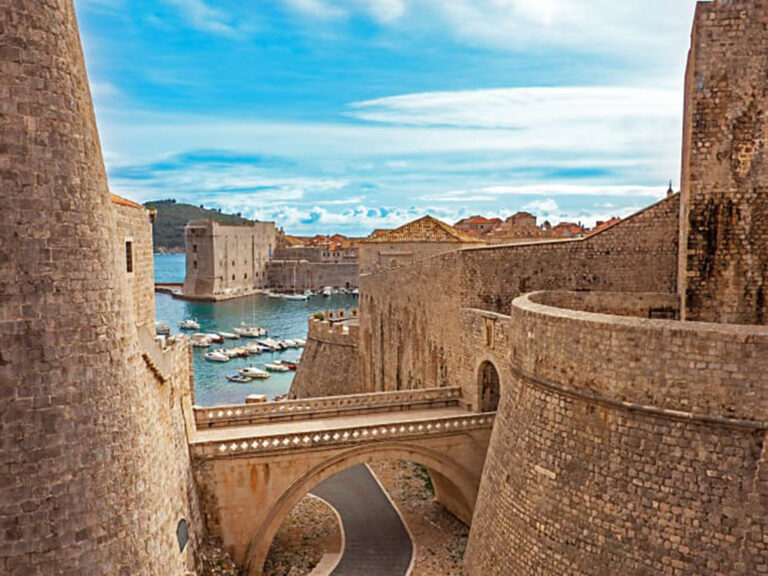
The Moorings Expands in Croatia
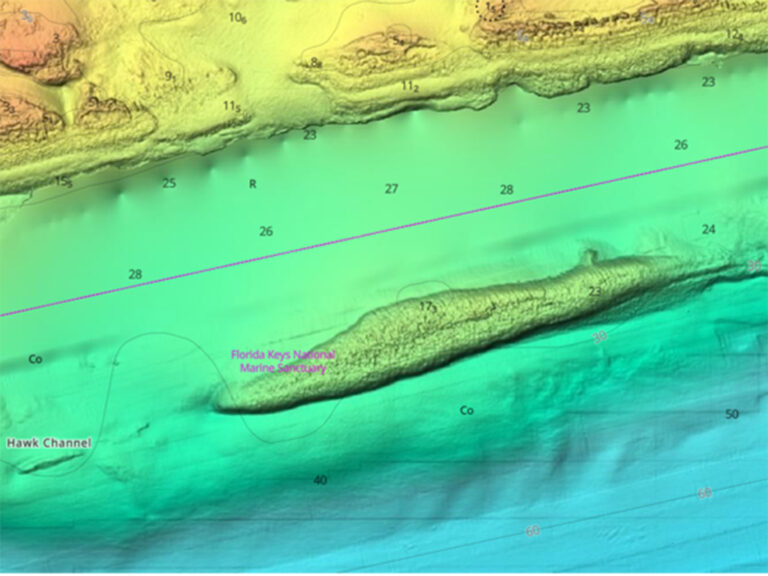
C-Map Updates North America Charts
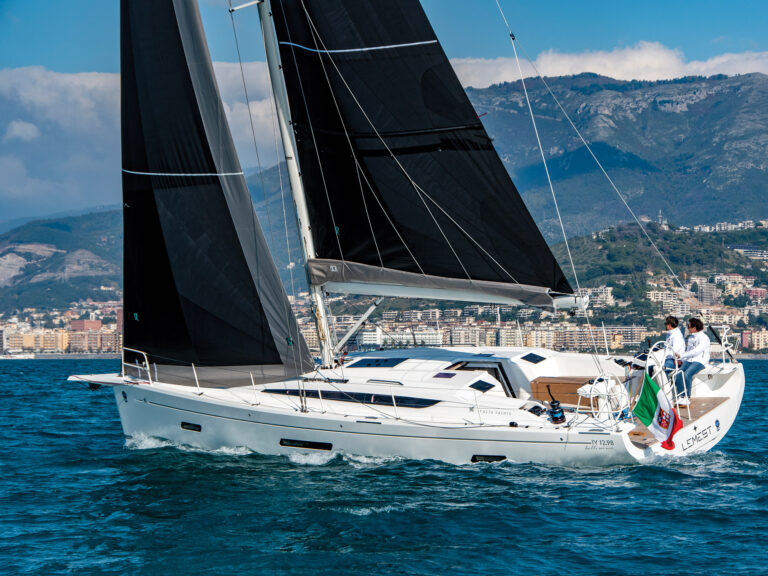
St. Vincent Court Orders Deportation For Hijacking Suspects
- Digital Edition
- Customer Service
- Privacy Policy
- Terms of Use
- Email Newsletters
- Cruising World
- Florida Travel + Life
- Sailing World
- Salt Water Sportsman
- Sport Fishing
- Wakeboarding
Many products featured on this site were editorially chosen. Cruising World may receive financial compensation for products purchased through this site.
Copyright © 2024 Cruising World. A Bonnier LLC Company . All rights reserved. Reproduction in whole or in part without permission is prohibited.
Pearson Yachts Portal
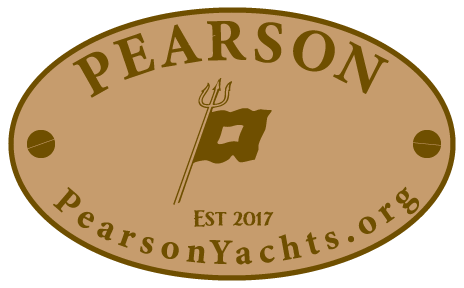
The Pearson 35 : 1968–1982
A sailboat that would combine superb handling, luxury accomodations and an underwater configuration that offered safe and comfortable cruising in both shoal and deep waters.
Safe and Comfortable Cruising
Luxurious and roomy describes the main cabin. Redesigned to offer additional space, the 35 offers upper and lower berths to starboard, settee/berth with upholstered black-rest to port, and a foldaway drop leaf table which seats six or folds neatly against the forward bulkhead when not in use. And overhead there’s a ventilation hatch for plenty of light and air. Stowage is provided in lockers and drawers under the berths and in bookshelves and lockers outboard to port.
The forward cabin has a bureau and shelf stowage. Four drawer lockers are under the roomy, double berth. A sliding door gives complete privacy. To port, in the passageway aft, is the toilet room with stowage outboard and under the vanity. Opposite is a hanging locker, another bureau, an shelf stowage.
At the bottom of the companionway ladder is a huge U-shaped aft galley. To port is a gimbaled stove with oven, large sink, trap stowage under the expansive counter. Shelves and food lockers are located above, and there’s drawer stowage under.
On the starboard side of the galley is a large counter area for navigation. Underneath is a roomy, top-loading icebox. Above and below are additional areas for stowage of navigation equipment, food and utensils. The oilskin locker is something you’ll find very useful.
The more you appreciate the amount of time you spend in the cockpit, sailing or sitting at the mooring, the more you’ll appreciate the Pearson 35’s huge 9’5" cockpit and well-placed pedestal steering.
Her deck plan adds greatly to the pure joy of cruising. Walkways are wide. The foredeck, with enclosed anchor well, is a large sunbathing platform. Winch island caps and toerails are rich teak. In the cockpit is a wealth of stowage space in the lockers port and starboard and in the lazarette aft.
Pearson’s wide choice of decorator fabrics for berths, color coordinated curtains and carpeting will delight the fussiest first mate.
When you think about performance in a yacht, consider this: The Pearson 35 has enjoyed the longest production fun of our entire line of auxiliaries. She’s earned the respect of all those who have a special fondness for a responsive balanced cruising yacht with exceptionally attractive lines and luxurious appointments. She might be called "the boat that made us what we are today."…We may build her forever… Come Sail with Us.
Pearson Yachts Inc. 1970

Arrangement Plan
Click to enlarge

Pearson 35 – by the Numbers
Hover on hyperlink for definitions
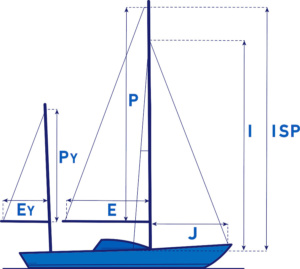
Forward Cabin: As most owners elect to use this cabin for their stateroom, it features, in addition to the classic V-berth arrangement, a hanging locker to starboard and a locker and bureau to port, providing ample stowage space without encroaching upon areas allocated to guests. A large forward hatch provides light and ventilation as well as ease of access from the deck. A sliding door provides complete privacy for the spacious owners’ quarters.
Toilet Room: Completely enclosed, with a sliding door, permitting passage fore and aft at any time. A molded fiberglass vanity unit, incorporating wash basin highlights the toilet room, soap dish, laundry trap, and expansive storage under. The sole is molded fiberglass, facilitating cleanliness and sump drainage for the optional shower. The inboard bulkhead is studded with individual shelves for personalized storage of toilet articles and the outboard side is given over to the large storage locker with sliding doors. Opposite the toilet room on the starboard side is a large enclosed hanging locker with extensive shelf storage above.
Main Cabin: Big headroom of 6’4" and beam of 10’ give this cabin plenty of room to live in. An L-shaped dinette opens up the floor space but, with an extension on the aft end, readily converts to a U-shaped dinette of a double berth when the table is lowered. A table leaf extends the size of the pedestal mounted table, accommodating seating on all four sides. An upper berth is built into the starboard side, with stowage beneath, and extension transom berth below. A translucent ventilation hatch overhead admits light and air into this commodious and most practical main cabin area.
Galley: Designed to please ship’s cook, the galley is located aft in the most convenient and comfortable part of the boat; features ultra modern materials and ingenuity. Stove and sink are to port. A 9 cubic foot icebox, with molded fiberglass liner, is adjacent to the oilskin locker on the starboard side. More then 12 cubic feet of enclosed storage space highlights this generous and expansive galley. There is even a deep, double level trap locker at countertop outboard of the stainless steel sink. Convenient pot storage is outboard of the stove recess and there are numerous drawers throughout; just the ticket to delight a cook who never before has had a place for everything.
Interior Décor: Exposed hull areas are covered in the luxury look of mahogany, high pressure laminates and vinyl. The headliner is of textured fiberglass; door and joiner work and paneled and hand finished to an exacting degree. A wide choice of contemporary colors are available for the vinyl mattress covers. The resultant décor is warm, rich and tastefully effected
Cockpit: An inviting 9 ½’ Cockpit extends aft to the transom providing convenient athwartship seating with the lazarette underneath. Large sail lockers are located both port and starboard. The teak capped fiberglass coamings are wide and high, comfortable to sit on or against, and incorporate wide winch base areas with handle stowage in cutouts under.
Deck Arrangement: Side decks on the boat are extra wide and uncluttered for safety and ease of sail handling. Forward and companionway hatches are large for easy access and good ventilation. In addition, a hatch has been installed aft of the mast to provide extra light and ventilation in the main cabin. Integral fiberglass moldings on the cabin top permit installation of the optional canvas dodger.
Hull form: The popular keel-centerboard combination makes possible adjustments to improve balance when sailing conditions change; permits shoal draft cruising.
Rig: the conventional masthead rig is the simplest and strongest method of staying a mast in use today. Also, and excellent ratio of sail area to wetted surface insures good all-around performance.
Comfort-minded racer: Beautiful new look in a sleek keel-center-board hull built for competitive racing and adventurous auxiliary cruising. Easy to handle, the Pearson 35 combines stable sailing, regardless of conditions, and fine racing performance potential. A deceptive 10’ beam provides generous accommodations for a boat this size, with wide decks and an extra long 9 ½’ cockpit. Two big cabins sleep 6 comfortably, include a private head, roomy galley and unique dinette arrangement.

I’ve often wondered what it takes to become a classic. Is it age, long-term popularity, the vote of experts? Or is it simply continuing acceptance on the part of those to whom the product is intended to appeal? My guess is that a classic represents a mark of excellence and an enduring quality that makes it as appealing as when it was first designed. I designed the first Pearson 35 in 1967 and she was launched shortly thereafter. Under TLS of three owners, interestingly enough she looks as beautiful today as the day we broke champagne on her bow. We set out to create a top-quality sailboat that encompassed these basic attributes while still retaining the ability to perform well under sail. In the twelve years we’ve been building the 35 we have made minor modifications to her interior but have never touched the hull or rig that give her the sailing qualities for which she is famous. During the last few years I’ve given some serious thought into why the 35 is as popular today as when she was first introduced. My opinion is that her undying popularity is a function of a unique combination of elements. And her handling, comfort, spacious interior accommodations and as enormous cockpit appeal just as much to owners today as they first did over a decade ago.

Pearson 35 Owners Sites
Pearson35.com
Pearson 35 Forum
Boat Reviews and Resources
Spinsheet (april 1999).
The first Pearson 35 was built in 1968 and the model remained in production, nearly unchanged, until 1982. As a testament to its popularity, this 14-year production run was the longest of any Pearson model built, surpassing the venerable Pearson 30 by four years. More
Practical Sailor (April 1999)
The success of the Pearson 35 was no accident. Like the Tartan 27, the Alberg 30, and its Pearson predecessors the Alberg 35, Vanguard and Triton, the P35 gave a broad spectrum of sailors the type of boat they were looking for: traditional design, contemporary styling, solid construction, and eminently livable space both in the cockpit and belowdecks. More
Blue Water Boats (March 2014 Update)
Shaw’s Pearson 35 has 7′ 6″ centerboard and 3′ 9″ full keel arrangement with connected rudder. She draws inspiration from the CCA rules of the day with her long overhangs, graceful sheer, and modest freeboard, and narrow beam by today’s standards. She is quite heavy with her 371 D/L ratio but has a respectable 15.9 SA/D ratio for light wind. More
PearsonInfo P35
A wealth of information on Pearson sailboats by Dan Pfeiffer. More
Pearson 35 Brochure

- New Sailboats
- Sailboats 21-30ft
- Sailboats 31-35ft
- Sailboats 36-40ft
- Sailboats Over 40ft
- Sailboats Under 21feet
- used_sailboats
- Apps and Computer Programs
- Communications
- Fishfinders
- Handheld Electronics
- Plotters MFDS Rradar
- Wind, Speed & Depth Instruments
- Anchoring Mooring
- Running Rigging
- Sails Canvas
- Standing Rigging
- Diesel Engines
- Off Grid Energy
- Cleaning Waxing
- DIY Projects
- Repair, Tools & Materials
- Spare Parts
- Tools & Gadgets
- Cabin Comfort
- Ventilation
- Footwear Apparel
- Foul Weather Gear
- Mailport & PS Advisor
- Inside Practical Sailor Blog
- Activate My Web Access
- Reset Password
- Pay My Bill
- Customer Service

- Free Newsletter
- Give a Gift

How to Sell Your Boat

Cal 2-46: A Venerable Lapworth Design Brought Up to Date

Rhumb Lines: Show Highlights from Annapolis

Open Transom Pros and Cons

Leaping Into Lithium

The Importance of Sea State in Weather Planning

Do-it-yourself Electrical System Survey and Inspection

Install a Standalone Sounder Without Drilling

Rethinking MOB Prevention

Top-notch Wind Indicators

The Everlasting Multihull Trampoline

In Search of the Snag-free Clew

What’s Involved in Setting Up a Lithium Battery System?

Reducing Engine Room Noise

Breaking Point: What Can Go Wrong With Your Yanmar?

Mildew-resistant Caulks for Boats

Can We Trust Plastic Boat Parts?

Repairing Molded Plastics

Mailport: Marine plywood, fuel additives, through bolt options, winch handle holders

The Day Sailor’s First-Aid Kit

Choosing and Securing Seat Cushions

Cockpit Drains on Race Boats

Rhumb Lines: Livin’ the Wharf Rat Life

Resurrecting Slippery Boat Shoes

Shoe Goo’s Gift to Sailors

Tricks and Tips to Forming Do-it-yourself Rigging Terminals

Marine Toilet Maintenance Tips

Learning to Live with Plastic Boat Bits

The Ultimate Guide to Caring for Clear Plastic
- Sailboat Reviews
The Modern Classic Racer-Cruiser
40-year-old islander 36 proves to be a comfortable and fast ride..
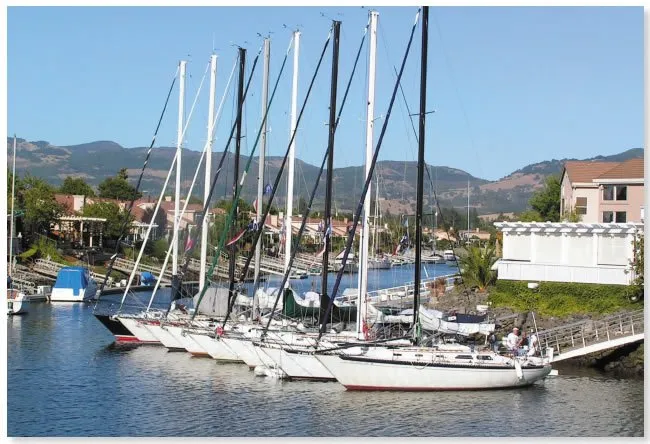
The Islander 36 was built from 1971 to 1985, making it one of the longest-lived 36-footers ever on the U.S. market. More than 750 of the Alan Gurney-designed racer-cruiser sloops were built, with production spanning almost the entire history of Islander Yachts.
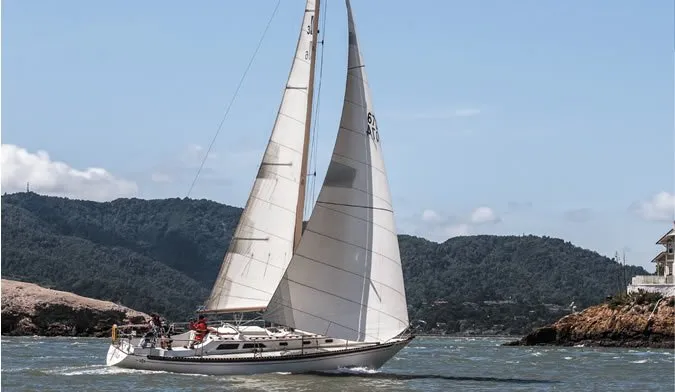
When it was first introduced, the Islander 36 seemed conservatively modern in appearance, with a flattish but concave sheerline, a fin keel, and a skeg-mounted rudder. The boat was designed as a racer-cruiser under the then-new International Offshore Rule (IOR) , but you would be hard-pressed to say that the same rule could create both the I36 and a modern IOR design. The Islander 36 was launched during the infancy of the IOR, before boat designers took advantage of the rules loopholes. As a result, its hull shape is undistorted and bears more resemblance to a modern fast cruiser than to a contemporary IOR racer.
While custom boats were the biggest force in racing in 1971, it was still possible to be competitive in local regattas with a production racer-cruiser. That all changed very quickly. Boats like the Islander 36-which were out-designed under the IOR but were still reasonably fast and easy to sail-served as the foundation for the movement that became the Model A of handicap racing: the Performance Handicap Racing Fleet (PHRF). And still today, I36s often take podium positions in PHRF races, particularly where I36 fleets are most popular, particularly in the San Francisco Bay area.
Even by todays standards, the hull proportions of the Islander 36 are nearly ideal for a modern racer-cruiser. The beam is moderate and carried well aft, offering fairly good hull volume aft, so that the boat does not squat excessively when cockpit lockers are loaded with cruising gear. Despite the age of the design, the I36 is not dated in appearance. You could even say that the boat is a modern classic.
The Islander 36 is predominantly a West Coast boat, but youll find them throughout the U.S. Most of the owners responding to our survey use the boat for daysailing, club racing, and coastal cruising.
Sailing Performance
Despite being designed as a racer-cruiser with an IOR Mk I rating of 27.9, the Islander 36 was not a particularly fast or successful IOR boat. However, under the PHRF rating system, a well-sailed Islander 36 is a reasonably competitive boat; many are still active in club racing, with the largest contingent in California, where conditions are a good match for the I36.
The Islander 36s rig is a simple, untapered aluminum spar stepped through the deck. It has two sets of spreaders and double lower shrouds. The shrouds are set well inboard, and genoa tracks are set just outboard of the cabin trunk to take advantage of the tight sheeting angles.
The Islander 36 is well-balanced under sail, although like many boats of its era with relatively small mainsails, you need a variety of headsails to keep the boat moving her best in all conditions. While this isn’t a problem on a crewed racing boat, todays fast cruisers tend to have slightly larger mainsails so that less-frequent headsail changes are required. The original I36 sailplan shows genoa overlaps as large as 180 percent; genoas that large are generally a nuisance to handle and tack.
Both deep and shoal draft keels were available on the Islander 36. Most boats have the deep keel, and this version of the boat is generally about six seconds per mile faster. The shoal-draft boat has an additional 150 pounds of ballast to compensate for the keels higher center of gravity.
The mainsheet traveler is positioned at the forward end of the companionway hatch. Late-model boats have a small molded breakwater aft of the traveler so that a companionway dodger can be installed. On boats without the breakwater, installing a dodger is trickier. Since the mainsheet is attached almost exactly to the middle of the boom, sheet loads are fairly high, and youll need a winch to trim the main in heavier air.
Original steering, mostly Edson brand, was the typical chain and sprocket with the steering cable led through sheaves to a quadrant clamped to the rudder post. The boat was designed with a tiller, but most owners have retrofitted wheel steering over the years. Since there are very few owner complaints about excessive weather helm, changing to wheel steering was more a matter of personal choice than necessity.
You will find slight differences in deck layouts, depending on whether the boat has been used predominantly for racing or cruising. On racing boats, the primary headsail-sheet winches are usually located on the forward portion of the cockpit coamings, with the secondaries aft. That position is often reversed on cruising boats. Likewise, racing boats may have most halyard and lift winches mounted at the base of the mast; cruisers use fewer winches, mounted on the mast itself. For shorthanded family cruising and daysailing-the type of sailing for which the boat is best suited-we would suggest larger-than-standard multi-speed self-tailing headsail sheet winches installed on the coaming, near the helmsman.
The I36s cockpit is very deep, which can make it challenging for some to see over the cabin when seated. Other cockpit features make it less than ideal for offshore work: cockpit drains are fairly small and there is no bridgedeck. To comply with the International Sailing Federations (ISAF) Offshore Special Regulations for offshore racing, the companionway dropboards would have to be fixed in place up to the level of the aft cockpit coaming, which would make it extremely difficult to get below.
Like most boats with a long production history, a variety of engines were used in the Islander 36-and most have been replaced over the years-making generalizations about performance under power difficult.
The I36 was first powered with an Atomic Four gasoline engine; that was followed by the undersized Palmer P-60 gas engine, the optional Perkins 4-108 diesel, and then the optional Westerbeke L-25 four-cylinder diesel. Islander even used a Volkswagen diesel engine, the Pathfinder 42 horsepower, in the 36 at one point, and by the end of the boats production run, a 30-horsepower Yanmar diesel was used. Most of these original auxillaries have since been replaced.
The most common replacement engines youll find in contemporary Islander 36s are Yanmars, usually in the 30- to 37-horsepower range. They are lighter, and with about a 2:1 reduction and a 13-inch three-blade, fixed prop, the I36 can approach 7 knots in flat water.
Given this wide variety of engines-some left-handed, some right-handed-and the mix of fixed, folding, and feathering props, Islanders will often pull from one side to another when backing up. With all but the smallest two-blade, folding props, skippers will need good seamanship skills for well-behaved backing into slips and docks. The knack is to get the boat moving astern with modest power, idle to keep speed under 2 knots, then use the large rudder and skeg to ease into a berth.
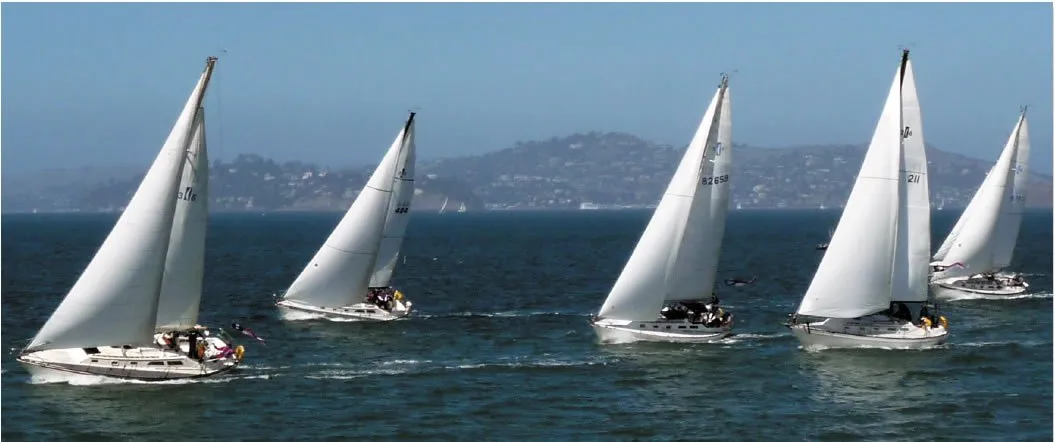
The Islander 36s interior finish is one of its best selling points. However, there are several interior-design shortcomings that are typical of boats of the early 1970s. Two of the biggest changes in boat interiors since then have been in navigation stations and galleys. The marine electronics boom had not begun in 1971. Loran C was new, and very expensive. Only hot race boats had wind instrumentation. Satnav was a far-off dream for recreational sailors, as were such things as personal computers and weather facsimile machines. For this reason, nav stations on cruising 36-footers in the early 1970s were rudimentary, when they existed at all.

The nav station of the Islander 36 is no exception. It is tucked away under the sidedeck, and the cabin sole in front of it slopes awkwardly upward. There are no drawers beneath the chart table, no good place for chart stowage. Theres no place to sit, and if you use the shelf above the table for electronics, theres no space for books. On late model I36s, there are drawers just forward of the chart table behind the port settee, but by modern standards, the boats nav station is nothing to brag about.
The shortfalls have given owners reason to use their sailorly ingenuity and a little creativity to come up with ways to add GPS, chartplotter, AIS, SSB, and radar instruments to the cozy nav station area. Youll find as many different solutions as there are I36s on the used boat market, and the I36 Owners Association website (www.islander36.org) offers some good examples.
The original I36 galley also is a relic from the days when a lot of people considered cruising in a sailboat just one step above camping out in a tent. The sloping cabin sole in the galley makes it difficult to work at the sink or reach the bottom of the icebox. There is relatively little counter space or storage space. There is no provision for galley ventilation except the main companionway, and without a dodger, the companionway cannot be left open in the rain because of the forward-sloping aft bulkhead.
A large number of Islanders were built with alcohol stoves, many of which have been replaced with propane or natural gas. Microwaves also have been added to current I36 galleys. Some I36s were produced with refrigeration systems, and many others have been added along the way. Pressure water systems are also common in todays Islander 36s, though not universal.
Aft of the nav station on the port side, there is a quarterberth tucked completely beneath the cockpit. The lack of ventilation in the quarterberth is a problem in warm climates, and its location is not one for the claustrophobic.
The main saloon itself is quite comfortable. The settees on either side are long enough to be comfortable berths. The starboard settee folds out into a double berth, but it is not the most convenient to set up or use. Above and behind each settee, there is a fair amount of storage space. Late model boats have lockers and drawers outboard of the port settee, while earlier boats have only a shelf. It would be fairly easy to build storage lockers in this area on an older boat, and many owners have.
Most boats of this size have fixed cabin tables, but the Islander 36s folds up against the bulkhead at the forward end of the main cabin. It is just possible to squeeze by the table along the starboard side when it is in use.
Ventilation is a weak point in the Islander 36, as it is with a lot of boats. Late model I36s have a ventilation hatch overhead in the middle of the main cabin; theres no reason you couldnt add one to an older boat. A hatch in the cabin trunk over the forward cabin provides fair-weather ventilation, but theres no provision for air?ow in bad weather. You can add cowl vents in dorade boxes, but the installation is tricky due to the vinyl headliner. The original foam and vinyl headliners had zippers to access the backs of fittings, but they tend to corrode shut. Many owners have opted to replace the headliners.
The head compartment is to port at the forward end of the main cabin, with lockers opposite on the starboard side. Headroom of over 6 feet is carried all the way forward. Drawers under the V-berth and a narrow hanging locker to starboard offer reasonable storage. A door at the aft end of the forward cabin can be secured in the open position to provide privacy for the forward cabin.
Conclusions
Unlike a lot of boats with long production histories, there are relatively few differences between the first and last Islander 36s. This means that youll likely be able to find a well-kept boat at a pretty good price. Most have seen systems upgrades and creative interior makeovers that make this modern classic a competitor for newer used production boats. The I36 also boasts a very active and large owners association, an invaluable resource for those buying-or thinking about buying-an older used boat. Since so many Islander 36s were built, theres a well-established used boat market, and you should not have trouble reselling one in the future, particularly if youre West Coast based.
Because of the cockpit design and relatively light construction, this is not the type of boat that we would choose for extended offshore voyaging, but there have been several I36s that have successfully raced from California to Hawaii, and a number have made circumnavigations. In our opinion, the I36 is best suited for coastal cruising, club racing, or even daysailing and weekend getaways.
As with any older boat, a careful survey is mandatory. Pay particular attention to the chainplates, gelcoat condition, rig, and the mast step. We would also look hard at the engine installation, fuel system, and the hull structure near the mast. Try working in the galley and at the chart table to see if you can live with them.
All in all, the Islander 36 is a well-mannered, fast-sailing boat, at its best in a breeze. With proper, modern sail-handling equipment, it can easily be handled by a couple for shorthanded cruising. With good sails and a smooth bottom, it is also can be a competitive PHRF club racer.
Owners Comments
The boat is easy to sail single-handed, especially with an autopilot. It has great speed and points well into the wind. It offers plenty of space for a single person or a couple for full-time cruising. I upgraded the galleywitha three-burner stove and oven, and replaced the holding tanks. Im still working with the original Pathfinder 42-horsepower diesel engine. It has plenty of power, butit isn’t always easy to find parts or someone to work on it. – Len Diegel; Katana, 1980 Islander 36; Lake Grapevine, Texas
The I36 is a fun and fast boat in most wind conditions, and it does respectable in its class in local races. Improvements that would make the I36 even better would be the addition of well-placed cabin handholds to aid in moving about the cabin in bad weather, and a better-designed navigation station, which is too small and offers no place to sit. – Jack and Anneke Wolf; Trillium, 1976 I36; Muskegon, Mich.
We purchased our I36 in 2012, from the second owner who had maintained it in like new condition. This boat must represent the very best value in a coastal cruising boat for the San Francisco Bay area. Having been a racer for 40 years, my wife didnt appreciate sailing with me until we bought this boat and settled into pleasure sailing. Comfortable, stable, quick, and roomy all describe our experiences. It has put the pleasure into sailing for us. – Gene Novak; Fantasy, 1980 Islander 36, hull #581; San Francisco, Calif.
We have sailed the boat in 80-mile-per-hour winds with no problem. The Islander 36 is the perfect daysailer-coastal cruiser. My only criticism is with the galley, which is poorly designed and not very functional. – 1972 model, Texas
This is an excellent boat for cruising. It can be singlehanded with the help of self-tailing winches. Our aluminum holding tank failed. – l977 model, California
We bought the boat for its appearance, reputation, and size. Its a great boat for San Francisco Bay and the Pacific coast. Weve sailed it south to the Channel Islands and north to Canada. – l978 model, California
Very fast for a comfortable cruising boat. The boat seems to be a good compromise between being light enough to sail well and heavy enough to be safe and solid. Gelcoat has crazed in spots. – 1979 model, Michigan
The intermediate and lower shroud chainplate is pulling out of the bulkhead. – l980 model, California
The only real problem with the boat is lack of ventilation. It is an excellent blend of sailing performance for the cruising couple or club racer. I suggest looking for an older model since they are often exceptional buys and are essentially the same boat that was produced until 1984. – 1973 model, Florida
The cockpit sole is flush with the companionway sill, which is not a seaworthy setup for going offshore. The aft bulkhead is too slanted to leave the companionway dropboards out when its raining unless you have a dodger. – l980 model, Maryland
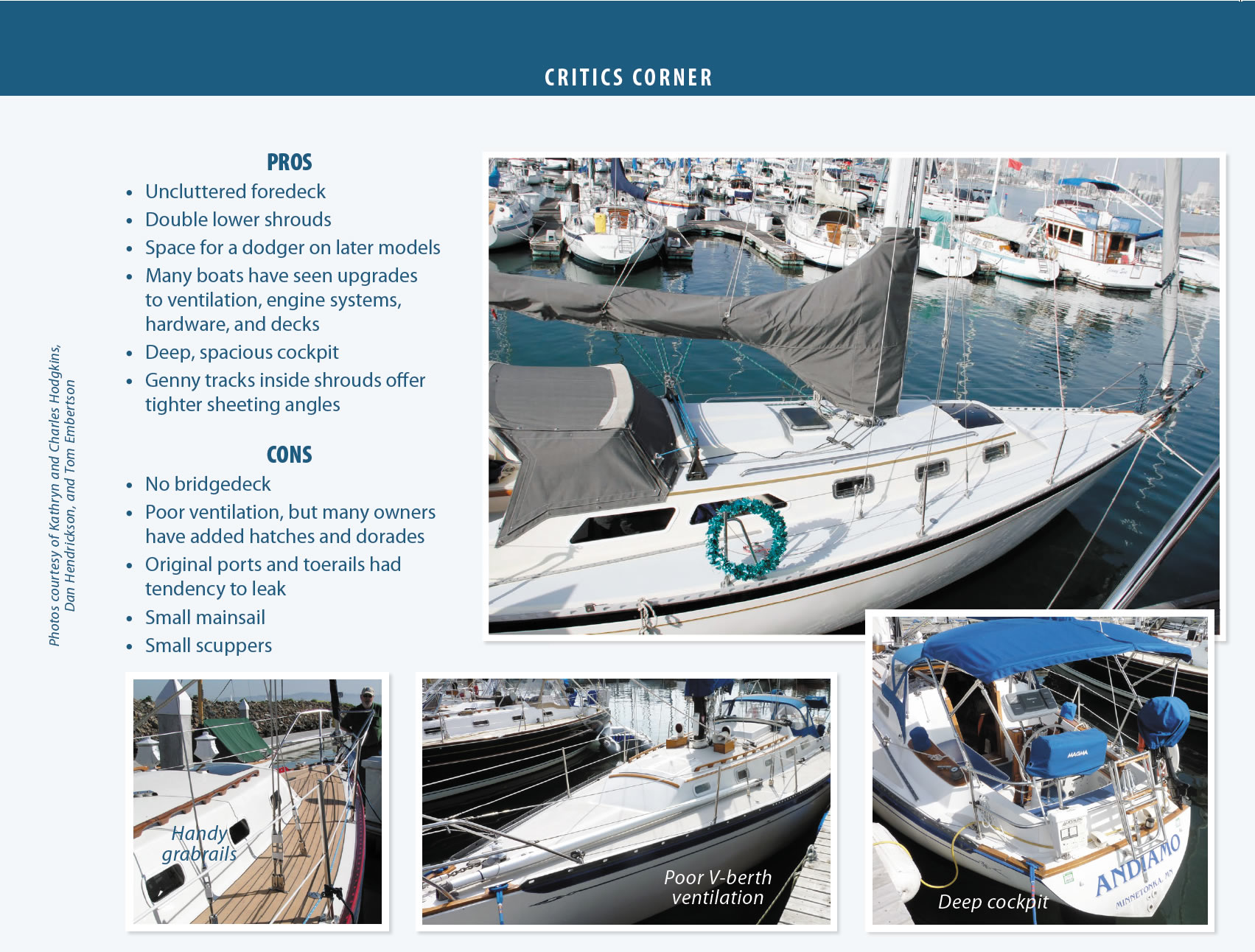
- Age Calls for Close Inspection
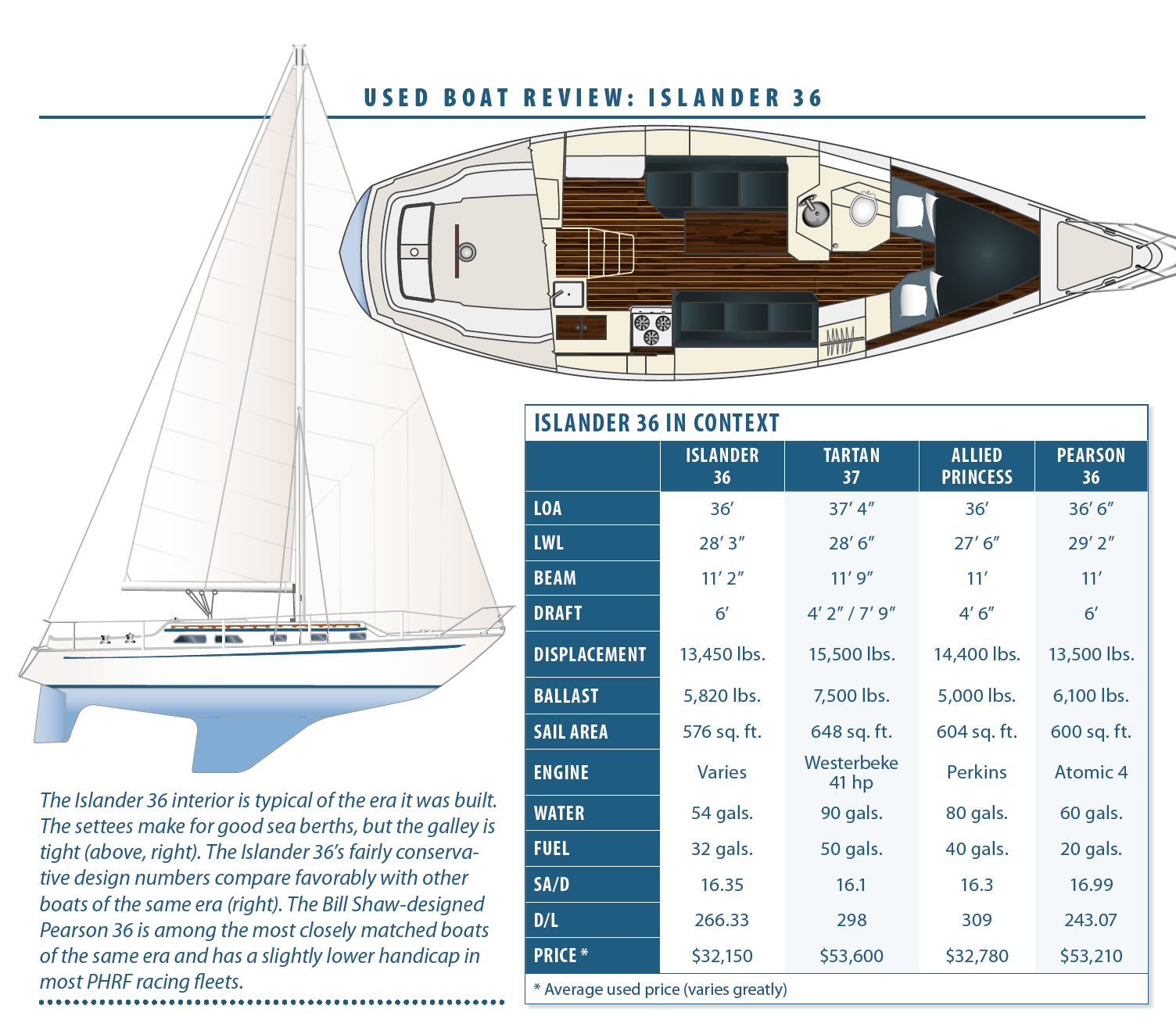
- I36 Owners Association
RELATED ARTICLES MORE FROM AUTHOR
Leave a reply cancel reply.
Log in to leave a comment
Latest Videos
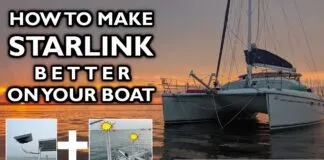
How To Make Starlink Better On Your Boat | Interview

Catalina 380: What You Should Know | Boat Review
- Privacy Policy
- Do Not Sell My Personal Information
- Online Account Activation
- Privacy Manager

- Forum Listing
- Marketplace
- Advanced Search
- About The Boat
- Boat Review Forum
- SailNet is a forum community dedicated to Sailing enthusiasts. Come join the discussion about sailing, modifications, classifieds, troubleshooting, repairs, reviews, maintenance, and more!
Bristol 35.5 vs 35.5C
- Add to quote
Looking for opinions/input on the blue water capability of the Bristol 35.5 vs the 35.5C. I live in North Florida, at 5'10" the draft may be too deep on a 35.5 for local usage (Keys, Bahamas) but I'm not sure about a swing keel boat nor do I see many affordable on the market. Anyone have any input about how limiting the fixed keel would be for us vs the swing/shoal type keel. 2 adults, 2 children, want blue water capable boat, looked at a Downeast 38- love the boat just not the one I looked at. I'd take suggestions on other boats but would like feedback on the 35.5 vs the 35.5C. IE- is it just too deep a draft for local fun? Is the C version just as steady in the big water?
I have the smaller sister, the 31.1 with keel. Very pleased with it, seems very seaworthy and the build quality is excellent. It seems you could pay to see these reviews of the 35.5C, if you don't have a subscription already : Practical Sailor - Bristol 35.5C - Boat Reviews Article Affordable Cruising Sailboats - Practical Sailor Article Any questions pertaining to my boat, let me know. You could also ask at the Yahoo Groups Bristol forum : bristolboatowners : Bristol Boat Owners
I have a Bristol 45.5 with a centerboard and am over 15,000 offshore miles. I would not be concerned with the centerboard model for offshore. We use our centerboard for a couple of purposes - going to windward and providing balance so that our Monitor windvane is more effective. Having the CB down, even a couple of feet dramatically reduces weather helm when power reaching. The rest of the time the board is up and we have less than 5' draft which was handy in the Bahamas and a few other places but of now significance in most cruising areas.
I've owned the 35.5C since 1990. I met a couple from the Irish Cruising Club that also owned one and they had been transatlantic 6 times in her. Since acquiring the boat I replaced the cable twice, once a few years after we bought it and once in 2015. I would definitely recommend getting the cable and centerboard pivot pin checked and or replaced before any ocean trips. I agree with @killarney_sailor 's comments regarding performance with the board down.
- ?
- 173.7K members
Top Contributors this Month

IMAGES
VIDEO
COMMENTS
The 35 was introduced in 1968 and remained in production for the next 14 years. In all, 514 P35s were built, almost all for East Coast and Great Lakes owners attracted by the 35's shoal draft (3′ 9″ with centerboard up) and "classic" proportions. Even the popular Pearson 30, usually heralded as the enduring boat from a builder ...
The Peterson 34 is as fast as it looks, and this quality solidified Peterson's reputation as a designer. The sloop's profile from abeam is sleek, the sharp cut bow and reverse transom give the boat a sense of forward motion. The dimensions are well proportioned—the 11-foot 2-inch beam is just about one-third of the boat's 33-foot 11 ...
Re: Reviving A Peterson 35 (Ganbare) I believe the original Ganbare was built in San Diego and sailed to the 1-Ton World Championship in the mid 70s, which put the late Doug Peterson on the naval architecture map. She was far less distorted than the IOR designs of the time, trading rating for speed. Geraghty Marine was building a number of Doug ...
Boat Review Forum. SailNet is a forum community dedicated to Sailing enthusiasts. Come join the discussion about sailing, modifications, classifieds, ... The Contessa 35 is a Doug Peterson design of the late'70s IOR era, not too different from the breakthrough Ganbare 35 at the time. As a Contessa I'd expect the build quality to be a cut above ...
From 1968-1982 the PEARSON 35 remained relatively unchanged and had the longest production run of any other Pearson model. Diesel power available as an option as was a yawl rig. Boats were delivered with a number of different engines including those from Farymann, Westerbeke, and Yanmar. Not the same as a much later PEARSON 35 (1997?) which is ...
Practical Sailor reviews nine used boats over 35 feet and under $75,000. By. Dan Spurr - Published ... I purchased a 1984 Doug Peterson designed Islander 40 for $65,000 and am still in love with the boat 15 yrs later. ... That is a Hoyt design from TCI. All I really gave up was some waterline. Below deck, the boat is as roomy as many 35-36 ...
Douglas Blair Peterson (July 25, 1945 - June 26, 2017) was an American yacht designer. Beginning with the One Tonner Ganbare in 1973, Peterson's designs have pioneered many innovations in racing and cruising yachts After nearly winning the 1973 International One Ton Cup, Doug Peterson stated in an interview: "I started putting boats down ...
The Pearson 35's were an older CCA era design. They sail pretty will for a boat of that era, but would be a mixed bag for cruising the Chesapeake Bay. Their shallow draft with the board up would allow them to get into many of the shallower anchorages, creeks and rivers. They were reasonably well constructed.
They went out of business in the 1990s, and the last Pearson 35 was built around 1980, with about 500 sold in total. Designed by Bill Shaw, the Pearson 35 is a 35-foot (10.7 meter) mast-head sloop with a water-length of 25 feet. A full keel and displacement of 13000 lbs (6 metric tons) means the Pearson 35 was designed conservatively by today's ...
Boat Review Forum. SailNet is a forum community dedicated to Sailing enthusiasts. ... The Peterson 34's and Contessa 35's had published ballast ratios approaching 47-48% while these second generation boats typically had ratios in the low 40% range.) and more fragile construction. ... and they generally have two types of wind there, little to ...
Oct 28, 2011. #2. There is an excellent review of the Pearson 35 in Gregg Nestor's "Twenty Affordable Sailboats to Take You Anywhere". If you're in the market for an affordable mid-size cruiser I highly recommend that book. My 1969 Pearson Wanderer is similar to the P35 but smaller.
The CONTESSA 35 was next, designed by Doug Peterson and spawning a run of over 70 further cruising versions of this One Ton Cup winner 'Gumboots'.. In recent years the intrepid sailor Erik Aaneraa has made the Contessa 35 even more famous the world over.. In 1975 the quarter tonner 'Hobnail' was launched and a further 22 of these CONTESSA 25 hulls were built.
The Peterson 44 features a low-profile center cockpit that remains pleasing to the eye and keeps weight low physically as well as visually. The long-fin keel with cutaway forefoot and afterbody reduces wetted surface for good light-air performance and provides a shorter turning radius. A full-size molded-in skeg supports the rudder and provides ...
Peterson boats for sale on YachtWorld are available for a variety of prices from $18,404 on the relatively lower-priced models, with costs up to $158,500 for the more lavish yachts on the market today. What Peterson model is the best? Some of the best-known Peterson models presently listed include: 44, KP 44, Center Cockpit Cutter and Center ...
Boat Reviews and Resources Spinsheet (April 1999) The first Pearson 35 was built in 1968 and the model remained in production, nearly unchanged, until 1982. As a testament to its popularity, this 14-year production run was the longest of any Pearson model built, surpassing the venerable Pearson 30 by four years. More . Practical Sailor (April 1999)
Boat Review Forum SailNet is a forum community dedicated to Sailing enthusiasts. Come join the discussion about sailing, modifications, classifieds, troubleshooting, repairs, reviews, maintenance, and more!
The ballast to displacement ratio of 33% states that the 44 is a light to moderate displacement boat that keeps upright in tough conditions. Theoretical hull speed is 8.3 knots and she will do that on just about any point of sail, given the right conditions. Not surprisingly, 180 nautical mile days are very attainable.
This from 'SPB' who worked at the Peterson Design office at the time: "The PETERSON 34 was different approach to the IOR rule. Less rule influence in the stern sections. Designed to be the next class down from the One Tonners (sometimes jokingly referred to as a 7/8 Tonner)." Some boats to this same design were built in Argentina. Alt. short rig:
The Islander 36 was built from 1971 to 1985, making it one of the longest-lived 36-footers ever on the U.S. market. More than 750 of the Alan Gurney-designed racer-cruiser sloops were built, with production spanning almost the entire history of Islander Yachts. When it was first introduced, the Islander 36 seemed conservatively modern in ...
Mortyboy Discussion starter. 1 post · Joined 2011. #1 · Jul 1, 2011. Looking for opinions/input on the blue water capability of the Bristol 35.5 vs the 35.5C. I live in North Florida, at 5'10" the draft may be too deep on a 35.5 for local usage (Keys, Bahamas) but I'm not sure about a swing keel boat nor do I see many affordable on the market.
It takes into consideration "reported" sail area, displacement and length at waterline. The higher the number the faster speed prediction for the boat. A cat with a number 0.6 is likely to sail 6kts in 10kts wind, a cat with a number of 0.7 is likely to sail at 7kts in 10kts wind. KSP = (Lwl*SA÷D)^0.5*0.5